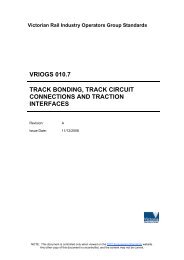VRIOGS 012.0.4 RevA - Public Transport Victoria
VRIOGS 012.0.4 RevA - Public Transport Victoria
VRIOGS 012.0.4 RevA - Public Transport Victoria
Create successful ePaper yourself
Turn your PDF publications into a flip-book with our unique Google optimized e-Paper software.
<strong>VRIOGS</strong> <strong>012.0.4</strong> Revision A 5<br />
4.3 Metropolitan Inner Area Numbering<br />
a) The Inner Area controlled signals, i.e. home, controlled automatic or dwarf<br />
signals have a three digit designation starting with an odd number. Each group<br />
shall have its own distinctive number as shown below. In addition some<br />
locations may also have a redundant three alpha character abbreviation of the<br />
location.<br />
The Clifton Hill Group Lines 100 to 199<br />
The Burnley Group Lines 300 to 399<br />
The Northern Group Lines 500 to 599<br />
The Caulfield Group Lines 700 to 799<br />
The Sandringham Group Lines 900 to 999<br />
b) Automatic signals and points shall be numbered as follows:<br />
The Clifton Hill Group Lines 000 to 099<br />
The Burnley Group Lines 200 to 299<br />
The Northern Group Lines 400 to 499<br />
The Caulfield Group Lines 600 to 699<br />
The Sandringham Group Lines 800 to 899<br />
c) Points are numbered one hundred less than the nearest signal reading through<br />
those points, e.g. the points in advance of signal 304 would be numbered 204.<br />
The points naming conventions are further defined as follows:<br />
i) If the signal covering the facing point move is a similar distance from the<br />
signals covering the trailing moves, the points shall be numbered 100<br />
less than the signal covering the facing point move.<br />
ii)<br />
If the signals covering the trailing move are located closer to the toe of<br />
the points than the signal covering the facing move, the points shall be<br />
numbered 100 less than the signal covering the trailing move for the<br />
normal lie.<br />
d) Track circuits shall follow the signal numbers as much as possible, but where<br />
additional tracks are in the block because of points, the point number or other<br />
spare numbers in the series shall be used. This is to avoid using such numbers<br />
as A302T, B302T, C302T, etc. The Train Describer computers are<br />
programmed to accept 3 digit numbers only and therefore the prefixes A, B, C<br />
etc. are unacceptable data. The track circuit naming conventions are further<br />
defined as follows:<br />
i) If a home signal opposes a dwarf signal over the same track circuit,<br />
the track circuit shall be named after the home signal.<br />
ii) If a home signal opposes another home signal over the same track<br />
circuit, the track circuit shall be named after the up direction signal.<br />
iii) If signals read through a set of points the track circuit shall be named<br />
after the points number.<br />
iv) If the track in advance of the signal has already been allocated due to<br />
any of the above conventions, the berth track for the signal may be<br />
named after the signal.<br />
v) Track circuits in the block, which after following the above conventions<br />
have not been named, shall be named using sequential numbering;<br />
NOTE: This document is controlled only when viewed on the DOT Engineering Standards website.<br />
Any other copy of this document is uncontrolled, and the content may be inaccurate.

















